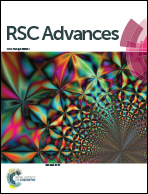An efficient process to directly convert 1-hydroxymethyl-3,5-dimethylpyrazole to Cd(ii) complexes via C–N bond creation: cytotoxicity and factors controlling the structures†
Abstract
We have demonstrated a simple process that involves one-pot, one-step reactions leading to efficient preparation of new cadmium complexes with N4-donating ligands [CdX2L1] (X = I− (1), Br− (2) L1 = tris(1-(3,5-dimethylpyrazolyl)methyl)amine). The most prominent feature of the synthesis is the in situ formation of a new organic tripodal ligand (L1) in a condensation reaction between a starting ligand (1-hydroxymethyl-3,5-dimethylpyrazole) and ammonia. A single-crystal X-ray analysis confirmed that the complexes obtained are monomers (1, 2) with octahedral geometry of the cadmium centres. Complex 3 has a cationic–anionic structure [Cu(LOH)2CH3OH][CdCl4] and has been synthesised by the reaction of CdO and NH4Cl in the presence of zerovalent copper (powder). IR, EPR, 1H and 13C NMR, as well as simultaneous TG/DTG were carried out to characterise the products. Moreover, we try to compare the cytotoxic profile of CdO and cadmium salts with Cd(II) complexes. Besides [CdX2L1] (1, 2) we take into consideration [Cd2(L2)2(SCN)4(MeOH)2]n (4) and [Cd(SCN)2L1] (5) complexes. Biological studies demonstrated that Cd(II) complexes with the N-scorpionate ligand (1, 2 and 5) have similar cytotoxicity, which points to a structure–cytotoxicity relationship. Thus, all the complexes (except 4) exhibited a lower cytotoxic activity compared to a cadmium ion in salts.


 Please wait while we load your content...
Please wait while we load your content...